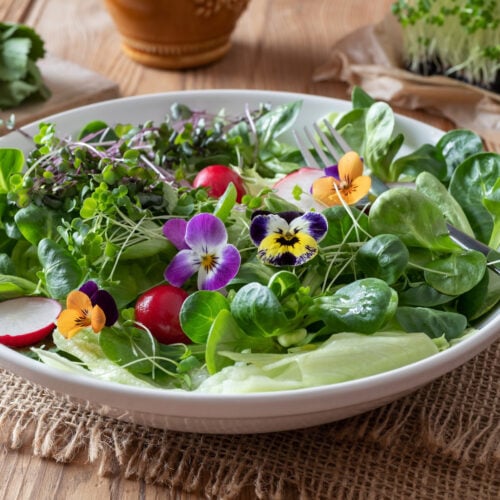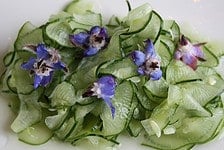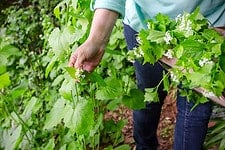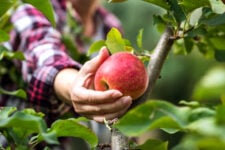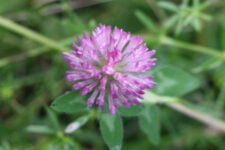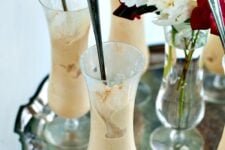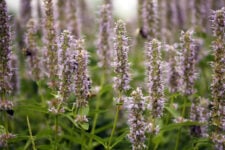When most people head out to the garden to harvest some tasty food for dinner, they’re usually on the lookout for fruiting bodies like tomatoes and cantaloupe. Or sometimes roots like turnips and carrots. Or maybe even leaves like mint and green onions.
But how often do you head into the garden looking for flowers to eat?
If your answer is rarely to never, this list is for you!
Edible flowers make a tasty addition to many recipes and pack a lot of unique nutrients and antioxidants that have special medicinal benefits. If you’re new to edible flowers, we have an extensive list of common varieties you need to try. We chose these flowers because most of them can be found in the vegetable garden or other plots around the yard.
Please keep in mind that not every flower is edible, and some flowers can be poisonous. Never eat a flower unless you are 100% certain it’s edible, clean, and free of contaminants, such as pesticides or herbicides.
Edible Purple Flowers
Alliums
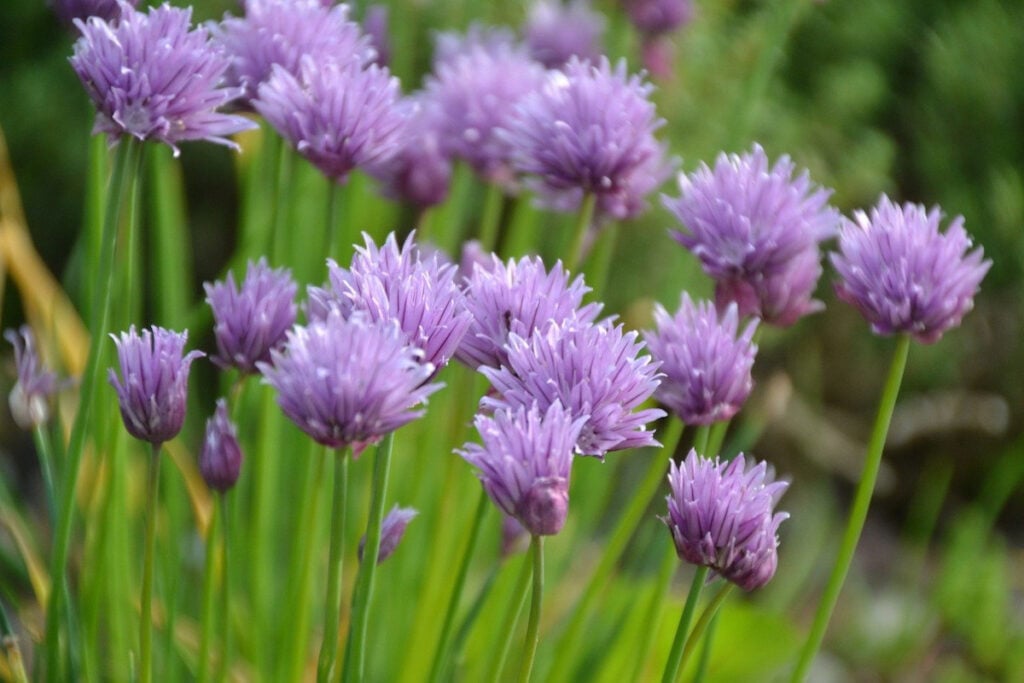
Plants in the allium family, which include popular produce favorites like onions, garlic, and chives, are well known for their unique, spicy, eye-watering bulbs. This flavor profile extends into the leaves, stems, and flowers of the plants as well.
In many species, the allium blossom doesn’t bloom until the second year the plant is in the ground. These tasty round flowerheads are worth the wait and are perfect for adding an oniony floral flavor to salads, vinegar salad dressings, and homemade butter.
Anise Hyssop
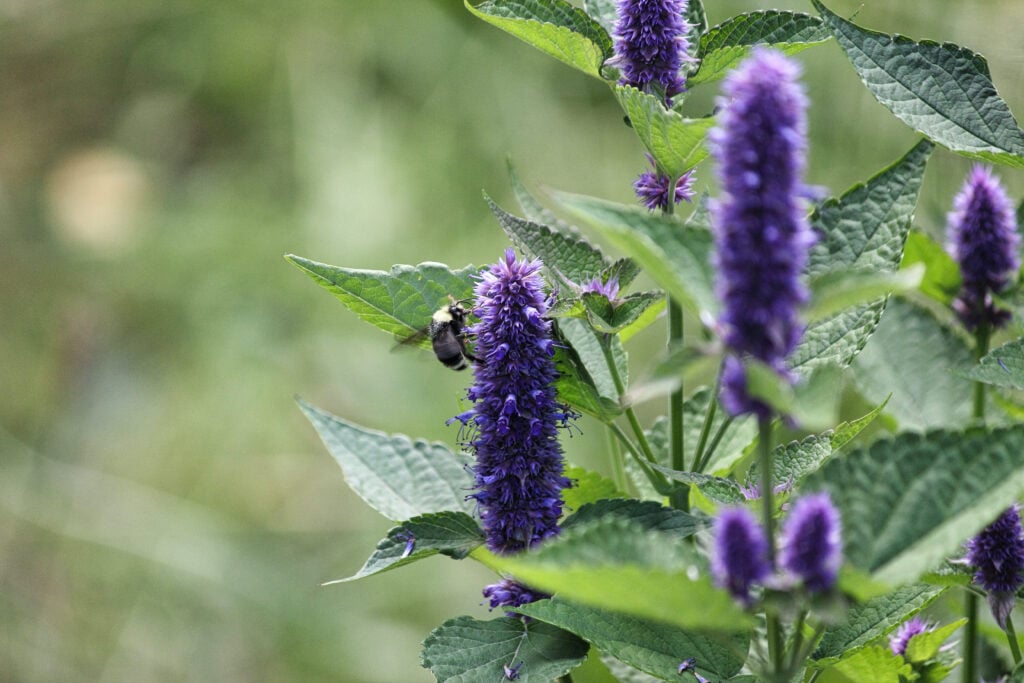
As the name implies, the flavor of these tiny purple flowers is somewhat licoricey. More so than the leaves, the flowers also have notes of floral sweetness that can add some serious depth to baked goods, homemade candy, and teas. I prefer to enjoy mine with poached peaches and cape gooseberries or as an addition to fruit jams.
Hostas
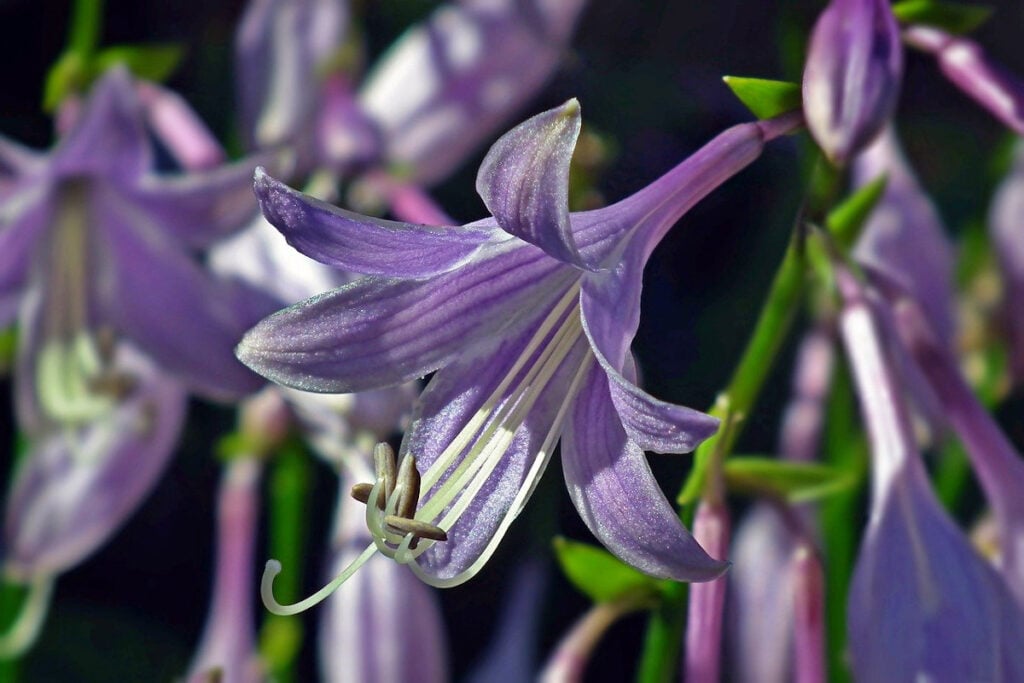
Delicate hosta flowers have a mild taste that won’t overwhelm any dish but will add some beautiful visual appeal. They are especially good sprinkled on salad or can be fried up into fritters.
Just don’t share your hosta harvest with your furry friend. While the entire flower is safe for human consumption, hostas are toxic to dogs and cats.
Lavender
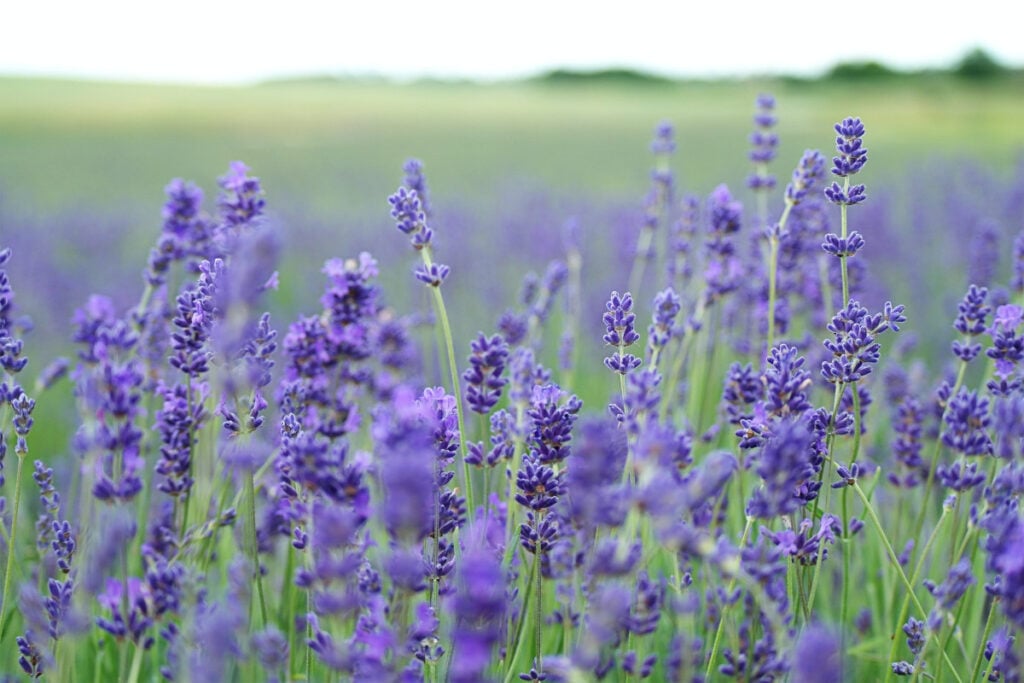
Is there anything lavender can’t do? This medicinal herb has long been used in teas, slaves, and aromatherapy to do everything from calm the mind to fight infection. As it turns out, lavender blossoms taste pretty good too and make a great addition to honey, baked goods, and jams. Lavender flowers have an intense floral taste with undertones of mint and rosemary.
Give it a try in this Lavender-Honey ice cream.
Lilac
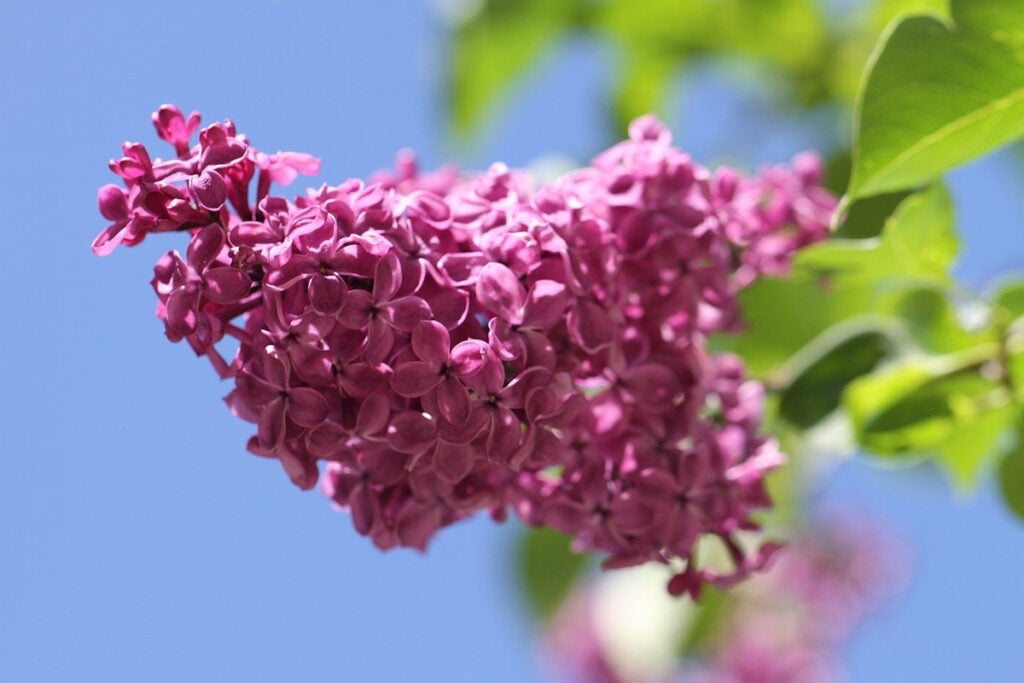
Unsurprisingly, these fragrant flowers also have an intense flavor. They are incredibly aromatic with undertones of lemon and a touch of bitterness. We like to use these amazing flowers to make lilac honey, but they are also a great addition to wines, liquors, and desserts.
Oregano
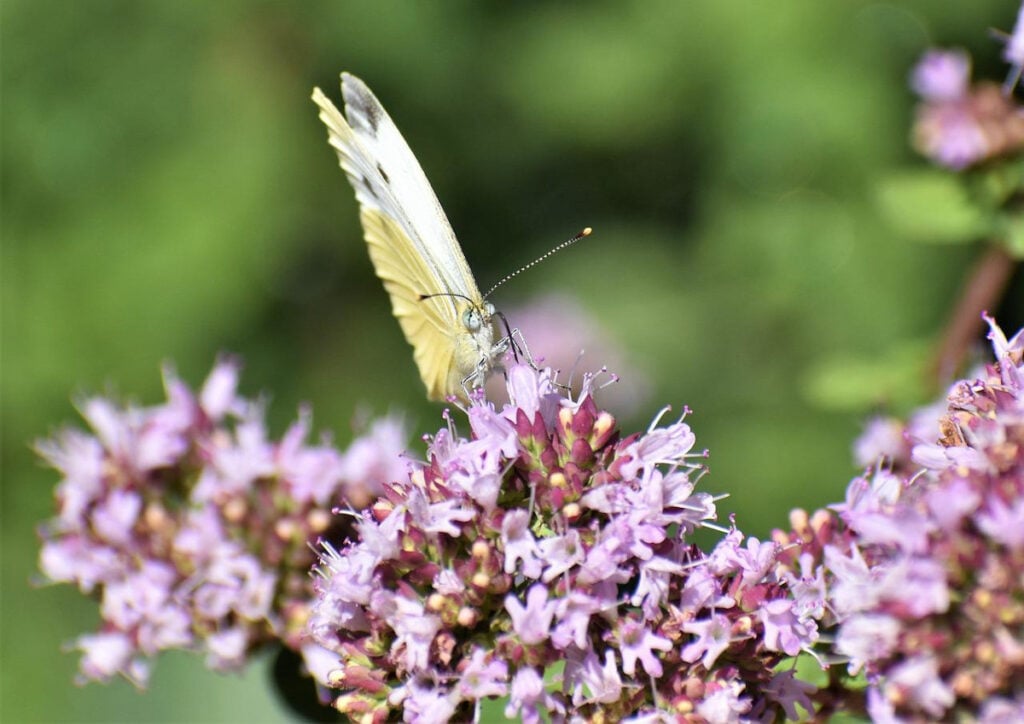
Seeing your oregano plant go to flower is usually a bad thing. It often means the herby leaves will become milder or even bitter. But it’s not all bad news. Those little purple flowers can also be harvested and used in the kitchen.
Oregano blooms have a much more delicate flavor to them and are often compared to the taste of thyme. This subtle spicy, herbiness is perfect for adding a little zest to summer salads.
Pansies
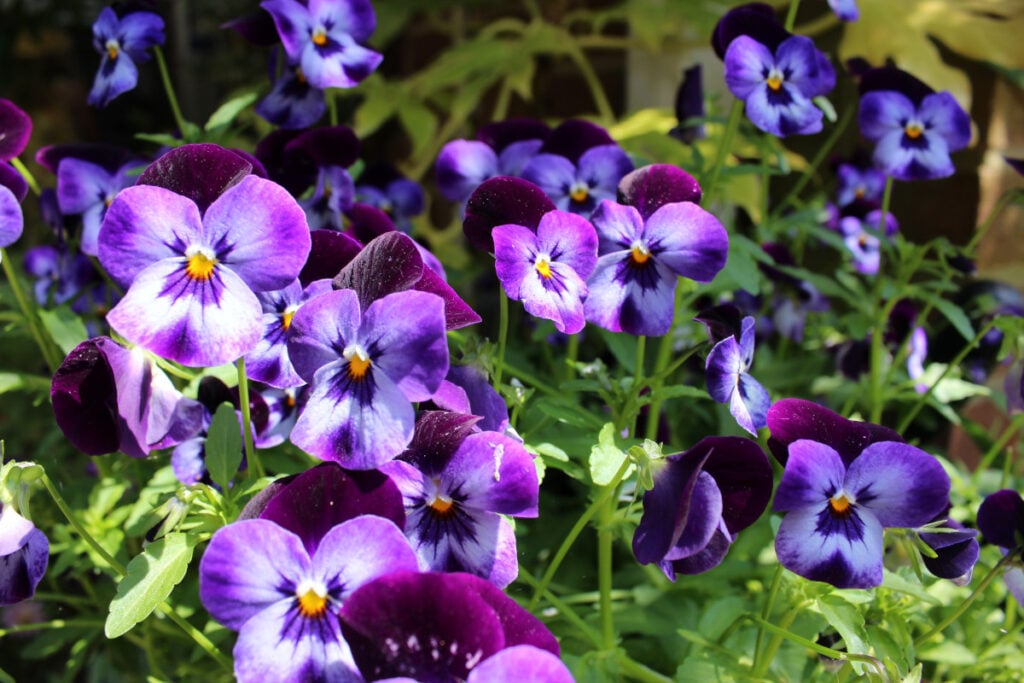
Pansies are a popular edible flower both due to the variety of colors they come in and their mild, pleasing flavor. The taste of a pansy bloom is similar to that of baby lettuce; it is slightly sweet with hints of wintergreen, perfume, or even bubblegum, depending on the variety. These colorful little flowers are most often eaten raw in salads or candied and used in desserts.
Thyme
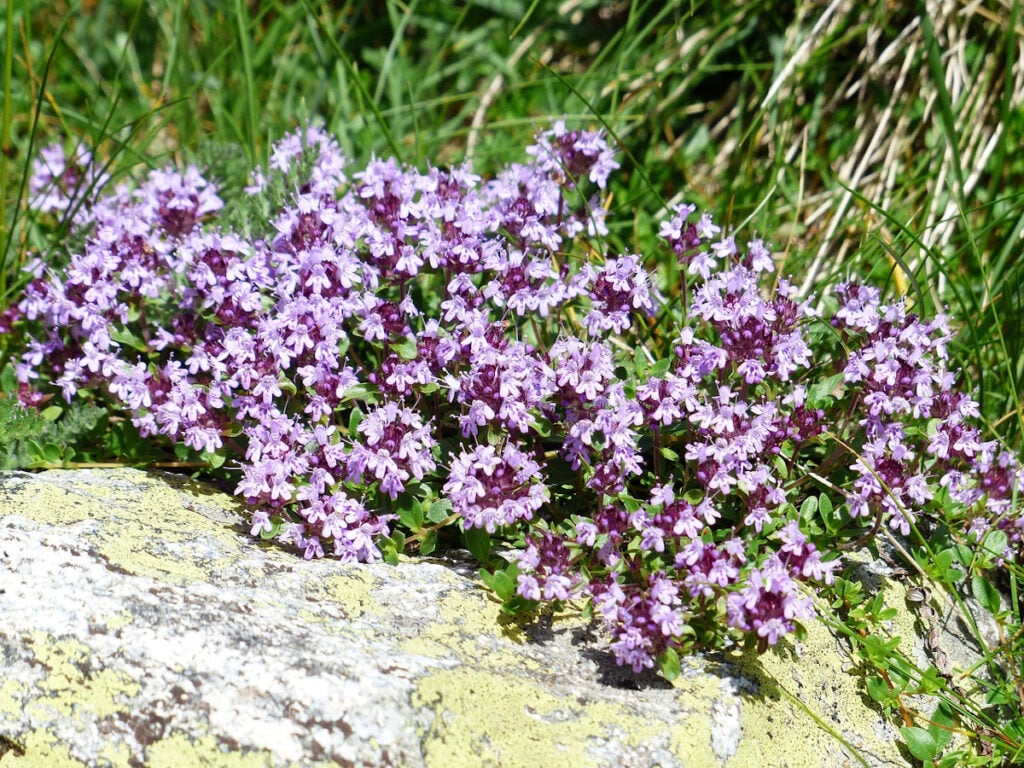
The delicate purple blooms on your thyme plant might spell the end for your fresh thyme harvest, but that doesn’t mean your plant is useless. These tiny flowers are milder than the leaves and have notes of citrus in addition to earthy mint.
That mild flavor makes them a great addition to raw salads. But where these tiny purple flowers really shine is as a gorgeous garnish on top of herby savory dishes like lasagna and alfredo.
Violets
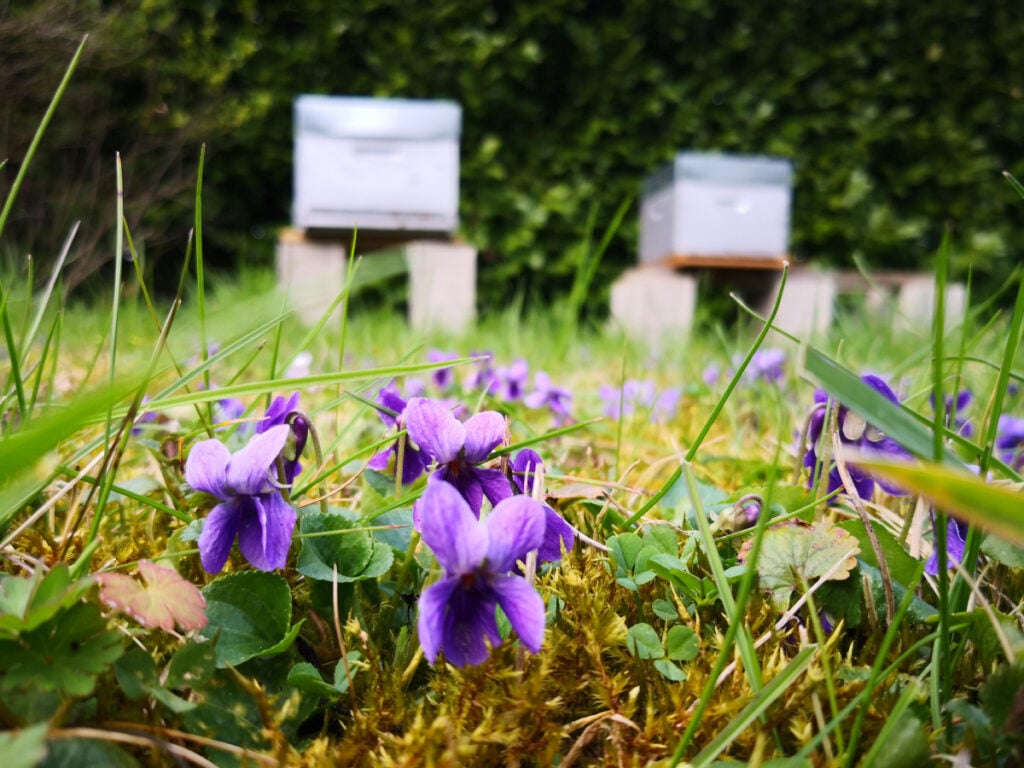
Like their close cousin, the pansy, violets are also edible and make a great, colorful addition to many dishes. They have a floral sweetness that goes great with fresh spring salads and delectable desserts.
Candied violets make a great addition to cupcakes, cookies, or as a simple pick-me-up in the middle of a long day. These purple flowers can also be used to make beautiful and tasty jellies.
See Also
Edible Pink Flowers
Begonia
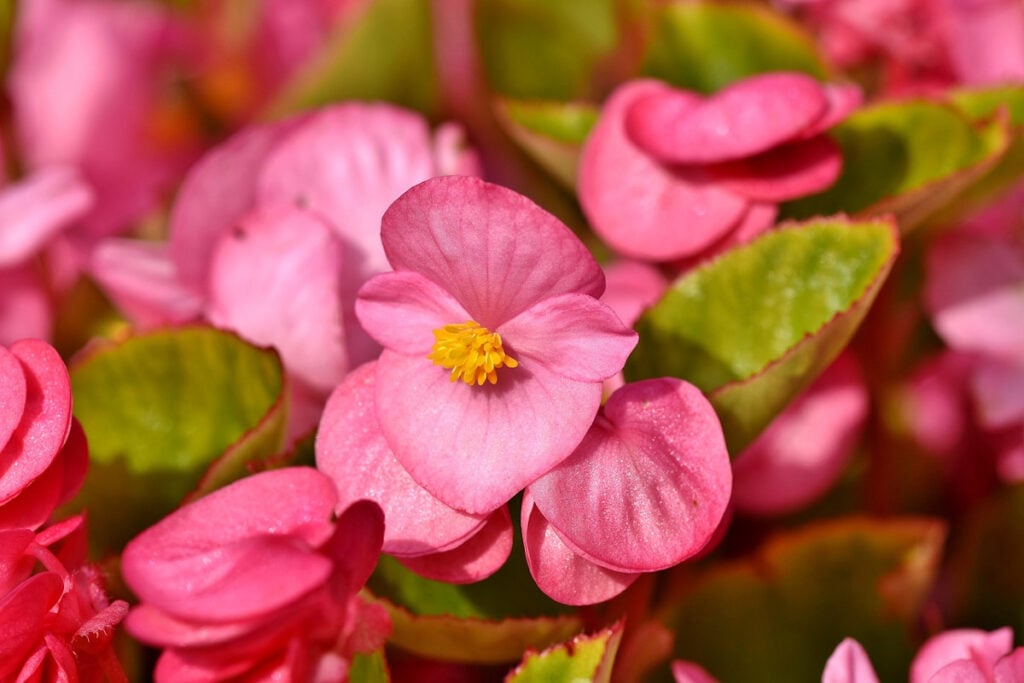
Begonias aren’t just beautiful, they’re also quite tasty. The flower petals add a fantastic dash of color to any recipe, savory or sweet, and have a mildly sour flavor, similar to that of a lemon.
These flowers can be cooked or eaten raw, just be wary of collecting flowers from nursery-grown begonias since these ornamental plants are often treated with toxic pesticides.
Carnations
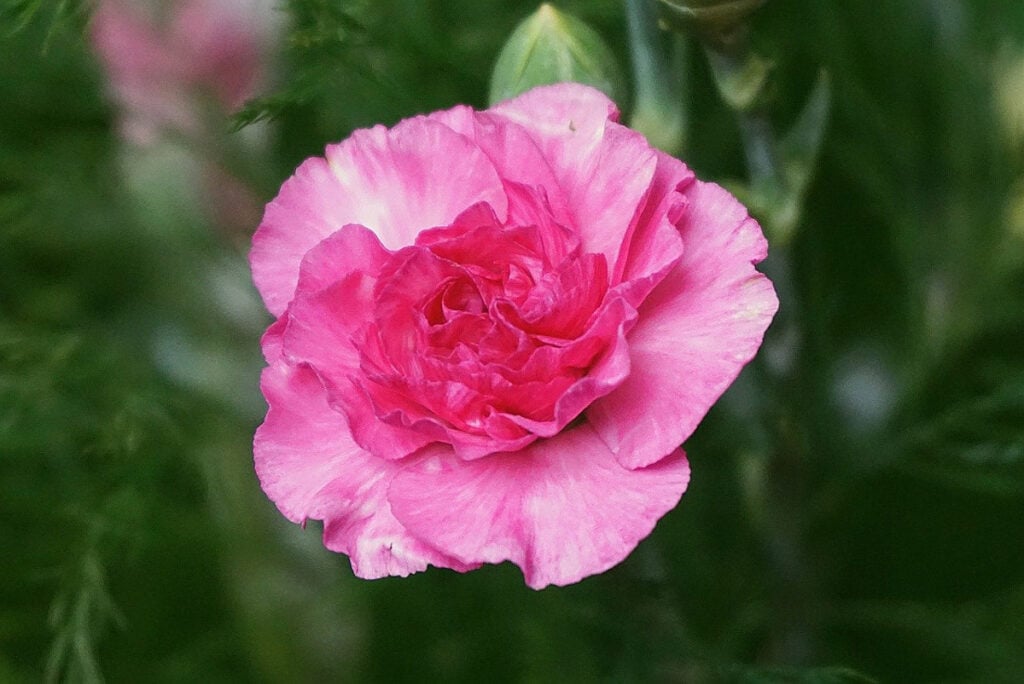
Carnation petals have a surprisingly sweet, slightly spicy taste that makes a great addition to baked goods and other desserts. Because they come in a variety of colors, they are prized for their use as edible decorations on cakes and other frosted sweet dishes.
Before you run off to the supermarket to pick up a dozen carnations to chow down on, know that most carnations found in stores have been treated with toxic pesticides. Only those flowers that have been grown organically without sprays should be consumed.
Hibiscus
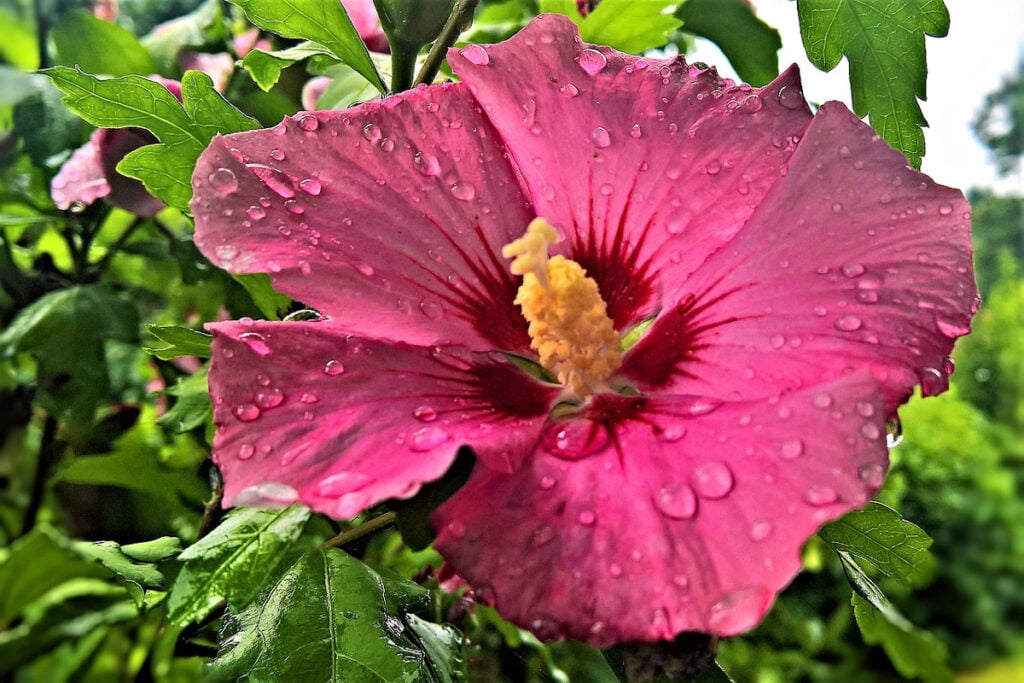
If you’re lucky enough to have hibiscus growing in your yard, then you have the chance to enjoy both the beauty and the exotic flavor of this tropical plant. If you’ve had hibiscus tea, you have some sense of what these gorgeous flowers taste like. They are tart with a slightly sweet taste and notes of cranberry-like flavor. Hibiscus flowers make surprisingly good additions to several dishes from tacos to cakes, and it adds a great flavor to kombucha.
Peonies
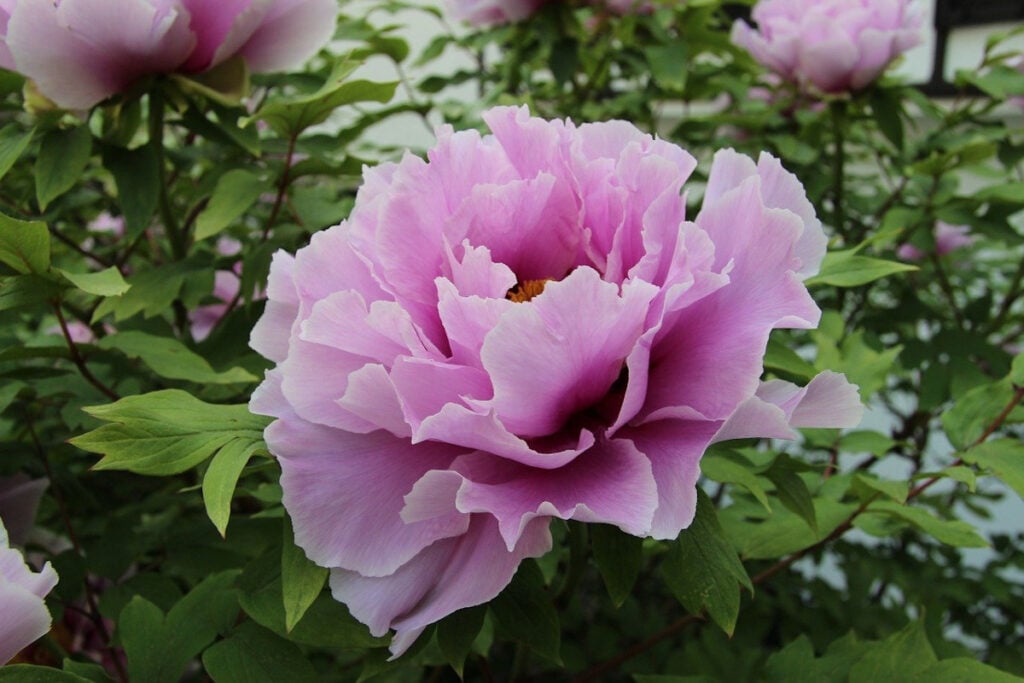
One reason fruits are often prized over the blooms they come from is that they offer a lot more in terms of volume of food. One flower that is big enough to challenge this idea is the peony. Just one of these huge blooms practically has enough petals to create an entire dish, and, considering they taste somewhat reminiscent of strawberry or peach, why not do just that?
The tender petals are best steamed and served with a light coating of sugar or added to water for a refreshing beverage. Or try them in this Peony and Rose Petal Ice Cream.
Redbuds
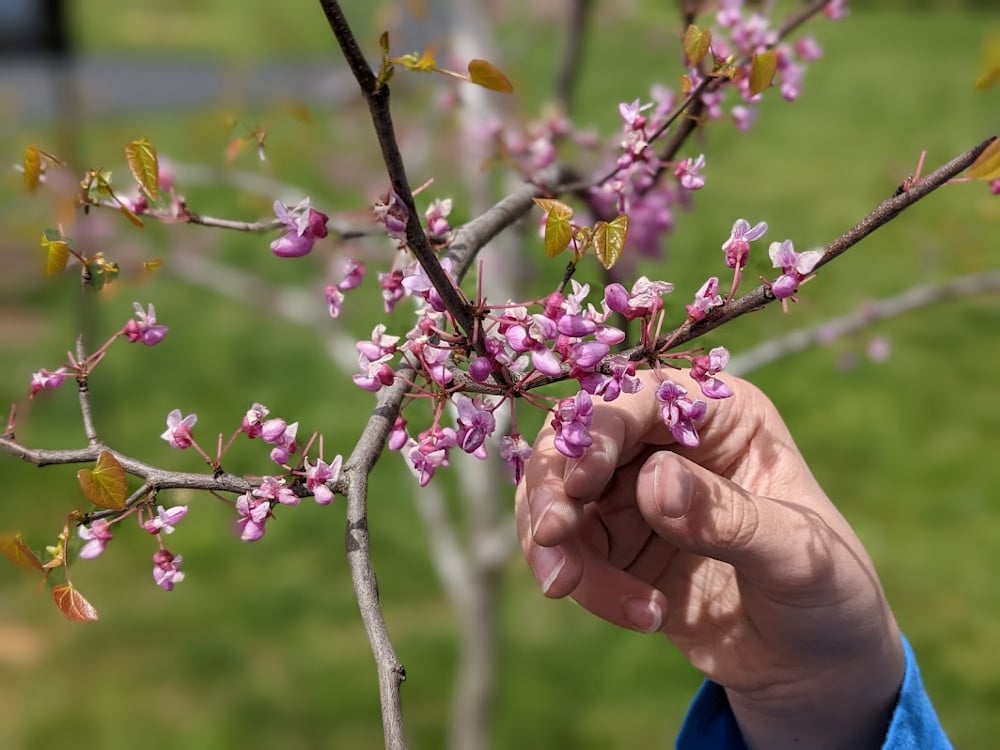
Don’t let the name confuse you, the buds of the Eastern Redbud tree may look red, but the flowers are the most spectacular shade of pink. And best of all, they have a subtly tart, highly floral flavor that makes them great for adding to jelly or for decorating cakes.
The Western Redbud tree, which is not closely related to the Eastern, also has edible pink flowers. These rosey buds taste somewhat like peas and make a gorgeous addition to salads.
Roses
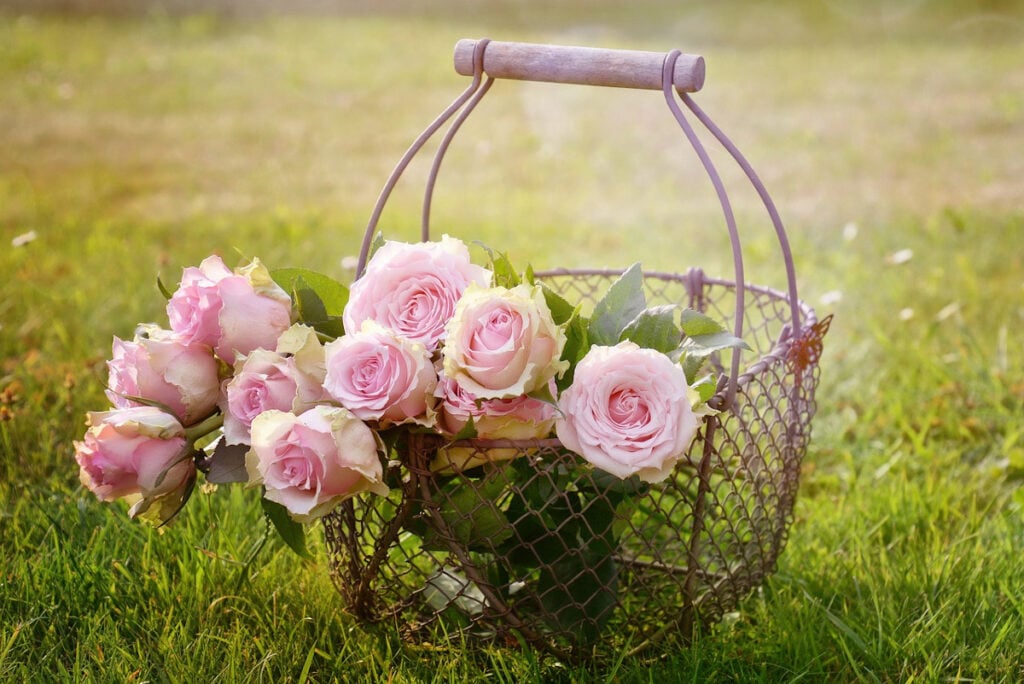
Rose flowers, as you can imagine, have a unique floral taste that is bright and familiar. Add a little sugar to that intense flavor and you have an instantly beautiful and delicious dessert.
Mixing rose petals with honey and brandy creates a medicinal rose elixir that can treat a number of conditions from heart palpitations to digestive upset.
See Also:
Edible Yellow Flowers
Arugula
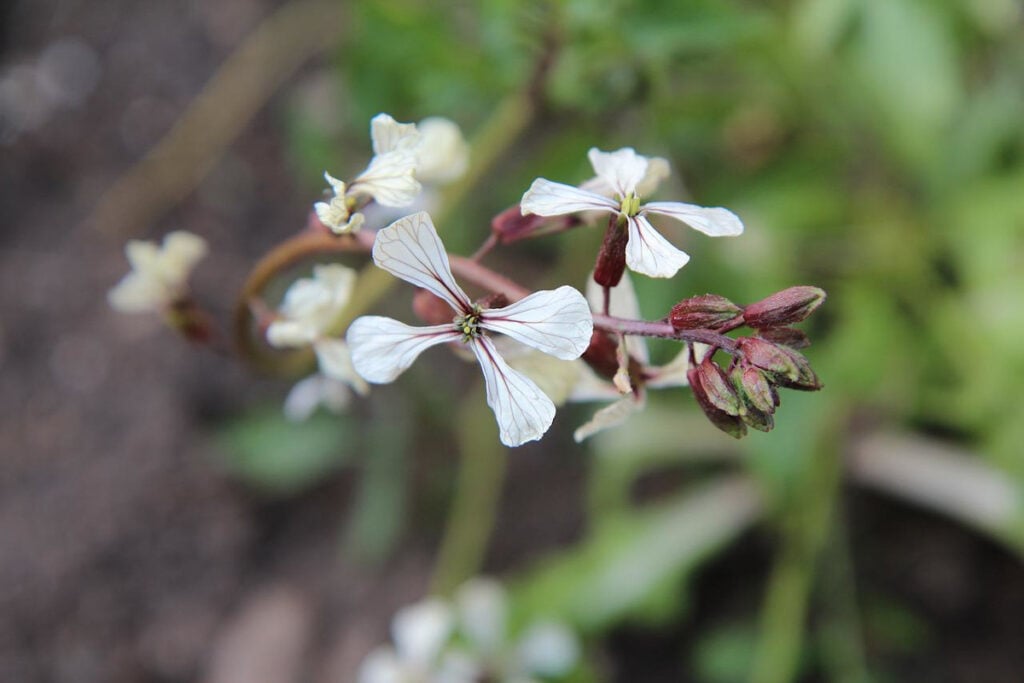
Like many plants in the family Brassicaceae, the yellow and white flowers of the arugula plant are completely edible. These unique-looking four-petaled flowers are zesty just like the leaves with peppery flavors upfront and nutty undertones.
Adding these to an arugula salad won’t affect the taste much, but it will add some beauty. You can also stir these flowers into egg or pasta salad to add some zest and visual appeal.
Broccoli Flowers
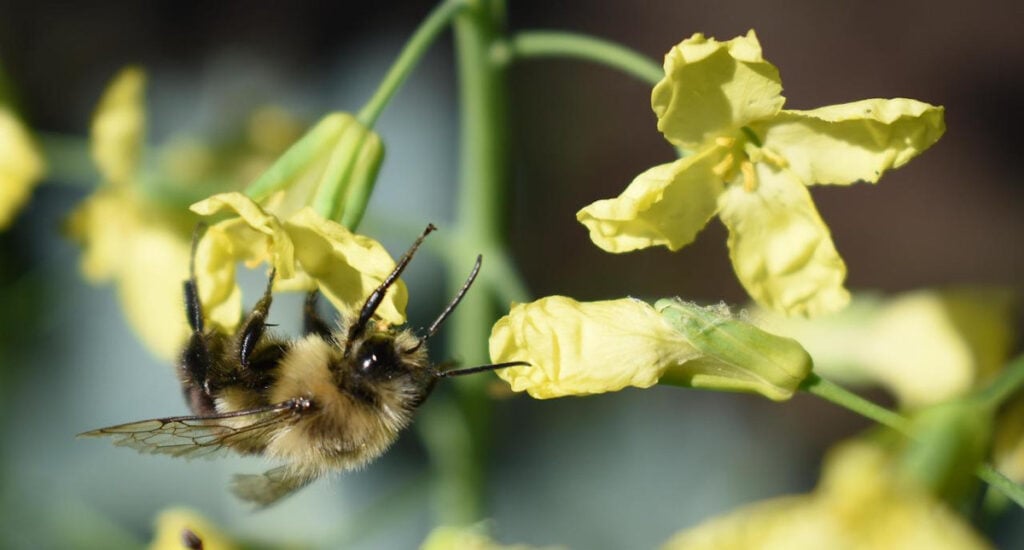
It should come as no surprise that broccoli flowers are edible. After all, we eat the buds of this vegetable frequently. But even when those buds are allowed to bloom into delicate yellow beauties, they’re still very edible.
In fact, these flowers are often sold at high-end markets as a delicacy. In addition to that familiar broccoli flavor, the open flowers have an extra sweetness and a touch of pepper flavor that make them great on salads or gently fried.
Calendula
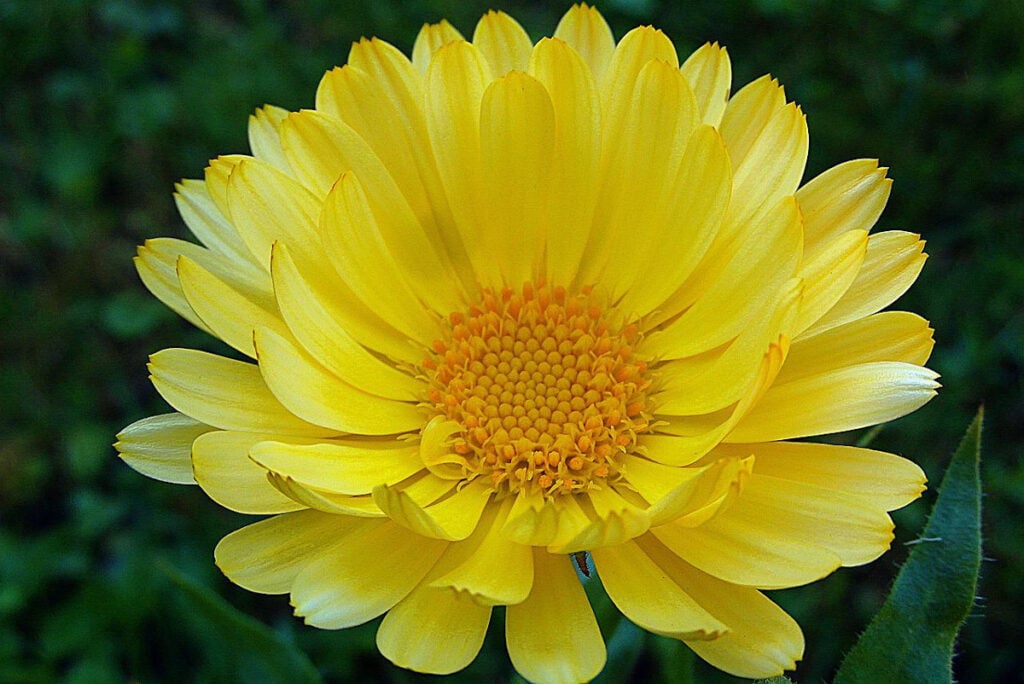
These bright yellow flowers have long been valued for their medicinal properties and are well known for their ability to calm skin irritations. As it turns out, calendula flowers are also edible and make a great addition to teas to help with many ailments from muscle spasms to sore throats.
The yellow petals can also be added to salads for an eye-popping garnish or to savory dishes to replicate the color of yellow cheese.
Dandelions
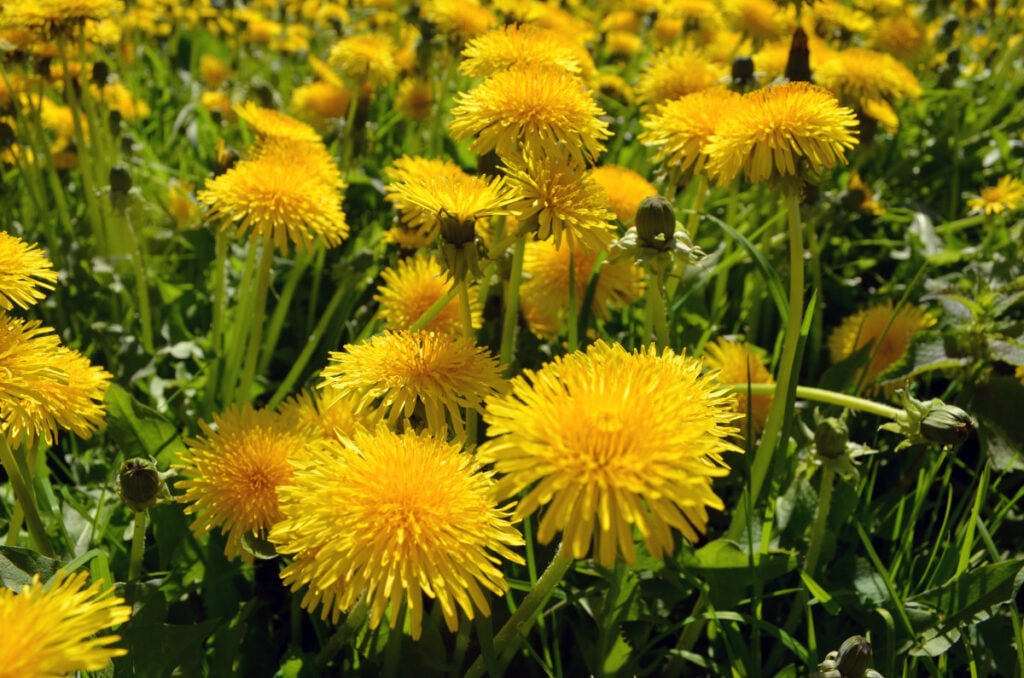
Most of us have more than enough of this common weed around our yards. Before you pick all those yellow buds and toss them in the trash, try popping the flowers off and adding the edible flower petals to your next salad.
Mature dandelion flowers have a slightly bitter taste while younger flowers are sweet like honey and make a great colorful addition to pancake batter. Both forms are a great source of vitamins and minerals, including iron.
Daylilies
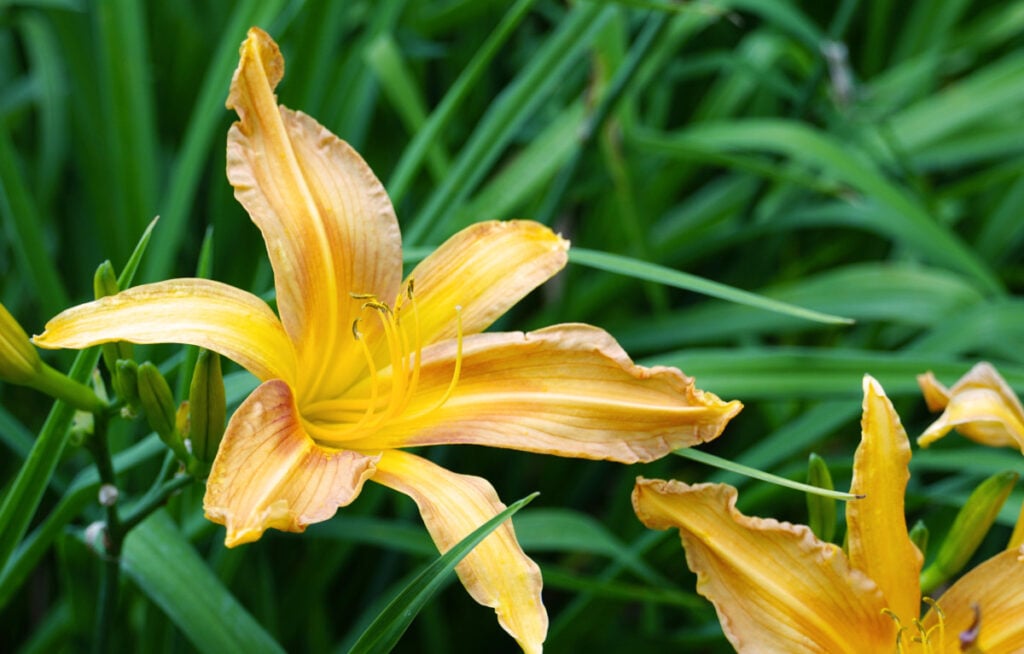
These common landscaping flowers are entirely edible and surprisingly delicious. The young, closed blossoms can be fried into what professional foragers call a ‘daylily fritter.’ The mature blossoms also make for a tasty treat. They have a sweet flavor, crunchy texture, and a floral aroma that you can taste and smell when eating them raw.
Kale
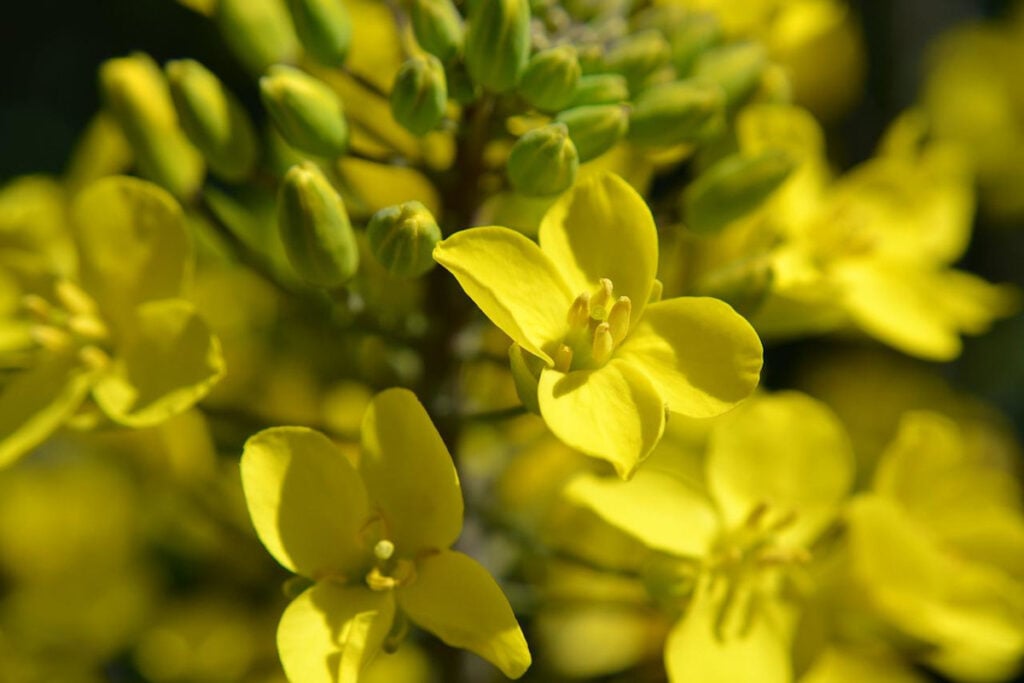
I have a kale plant in my garden that I’ve let grow through four winters. Now, this massive plant is as tall as me and produces hundreds of beautiful yellow flowers every summer. I’ve kept it around for the bees but, more recently, I’ve started using some of these little yellow blooms myself.
Unlike summer kale leaves, which are bitter and leathery, these flowers are sweet and delicate. If you have as many as I do, toss them in a wok and saute them with garlic for a tasty side dish. Or, if your harvest isn’t as plentiful, sprinkle them on your salad for a splash of color.
Squash Blossoms
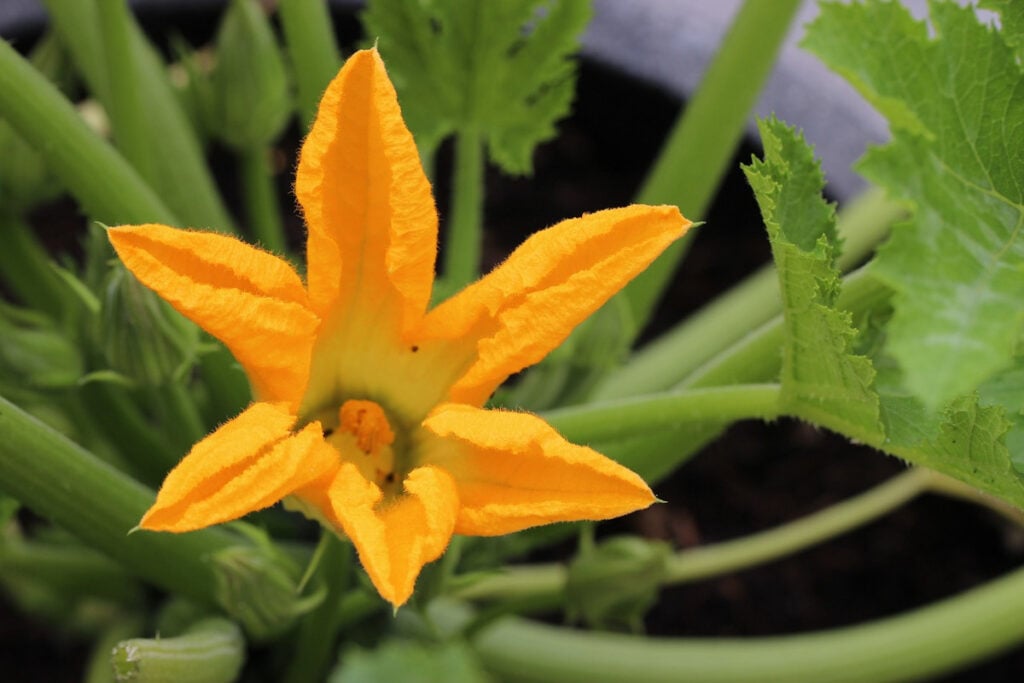
Understanding how to prepare and eat squash flowers is a great way to cut down on an overabundant squash harvest. Instead of choking down your third helping of zucchini bread in a day, harvest the blossoms before they can produce fruit (or harvest just the male blossoms so nothing goes to waste) and fry them up with a little oil for a tasty side dish or salad topper. Try this Avocado Salad Stuffed Squash Blossom recipe.
Sunflowers
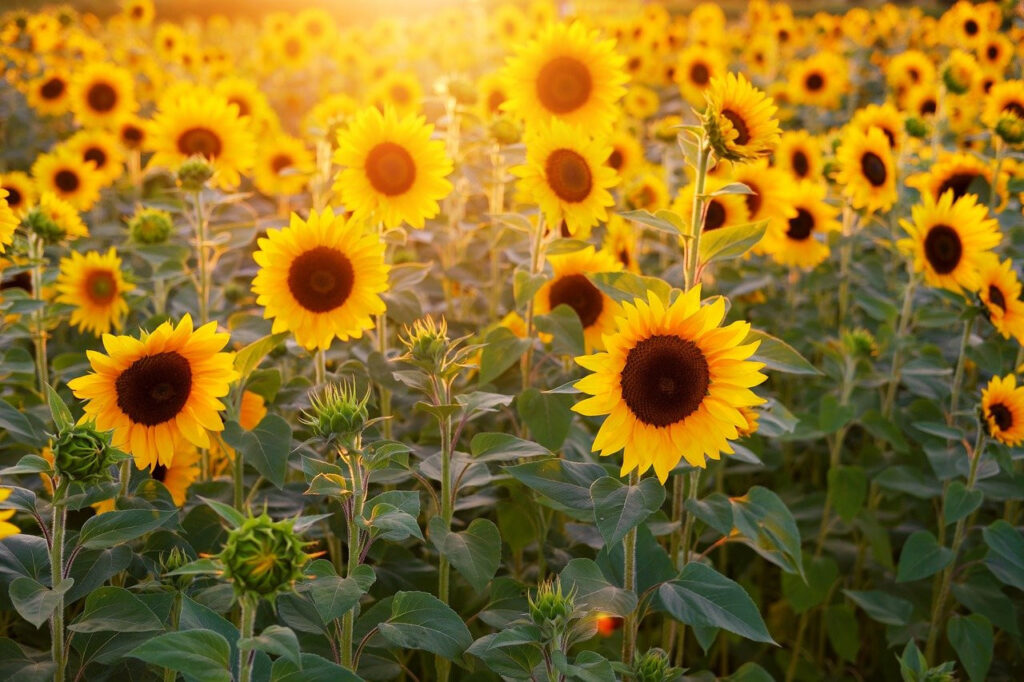
The seeds aren’t the only part of a sunflower that’s edible. The flower itself can also be eaten, though, preparation can be a little tricky. The easiest way to eat these oversized flowers is to pick the unopened flower buds and prepare them as you would an artichoke. The petals of mature flowers can also be eaten and make a colorful, summery addition to salads.
See Also
Edible White Flowers
Basil
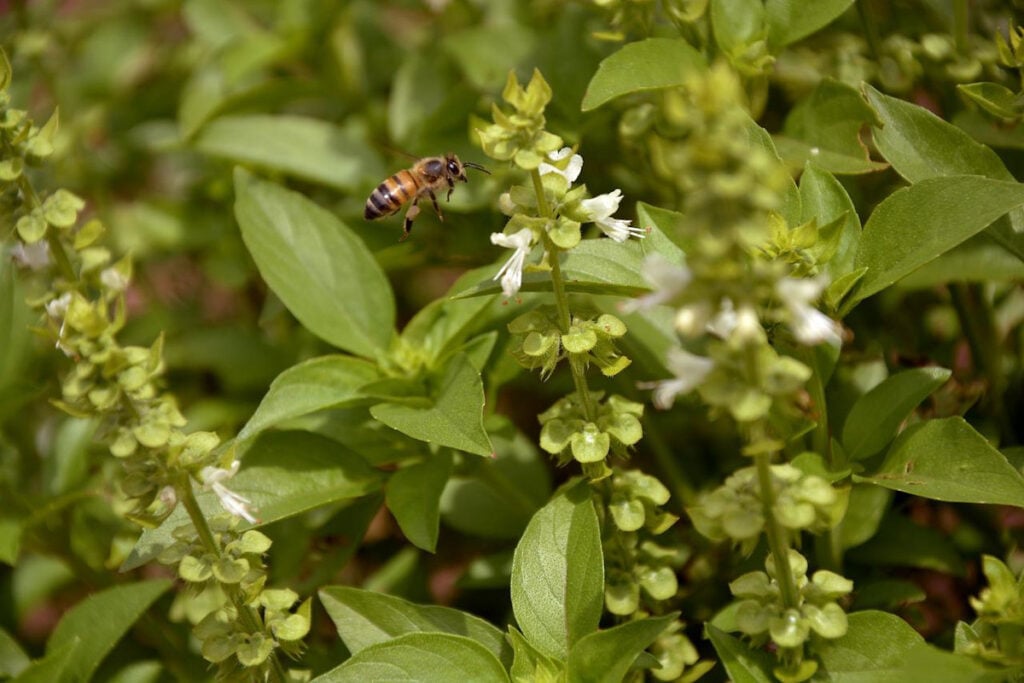
Basil flowers, which come in both white and purple varieties, are just as edible as the rest of this zesty plant. The open blooms tend to have a more mild basil flavor than the leaves. This makes them a great addition to raw dishes such as salads. They can also be used as a super-decorative garnish on pasta and other Italian dishes.
While most basil blooms are warm to slightly zesty, some can tend toward the bitter side. This is especially true if the plant has been blooming in hot weather for a while. So always be sure to taste the flowers before sprinkling them on your dish.
Cilantro
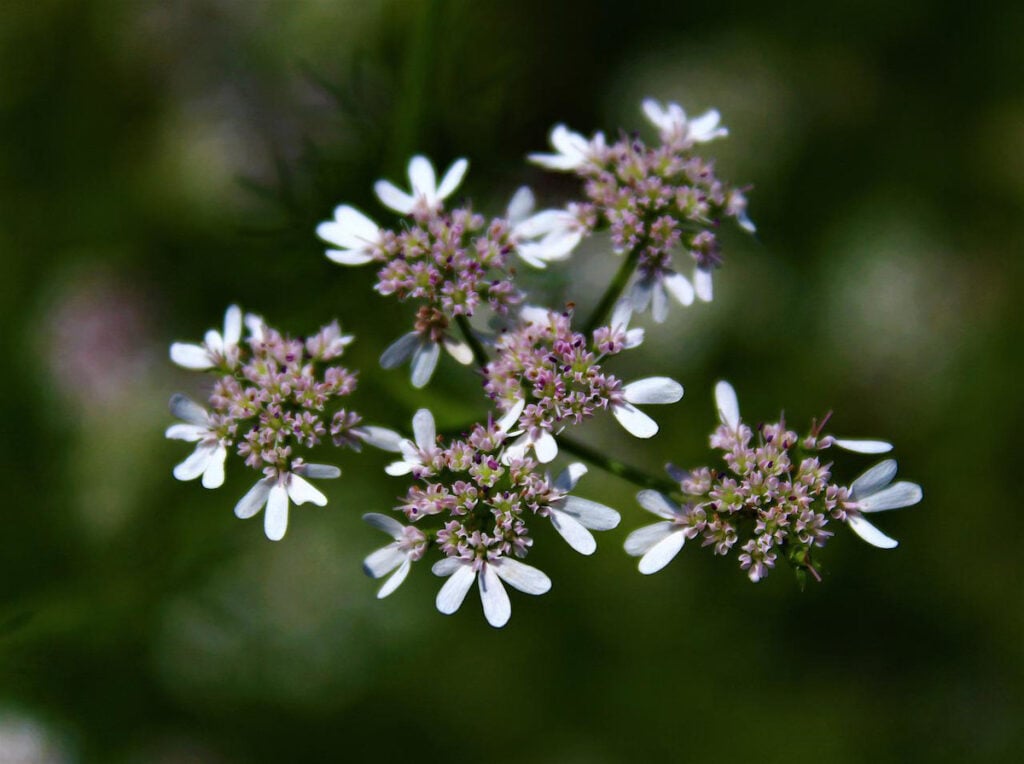
Once your cilantro plant casts up those delicate umbrellas of tiny white flowers, the harvesting season for the leaves is over. But the flower season has just begun.
These petite flowers have a milder taste with notes of citrus that balance the spicy-sweetness more completely than what you get with cilantro greens. Because they’re so small, using them for the decorative effect doesn’t quite work. But they can be used in place of or along with the greens in most recipes.
Just be sure to let some of those buds go to seed so you can harvest your very own coriander spice.
Daisy
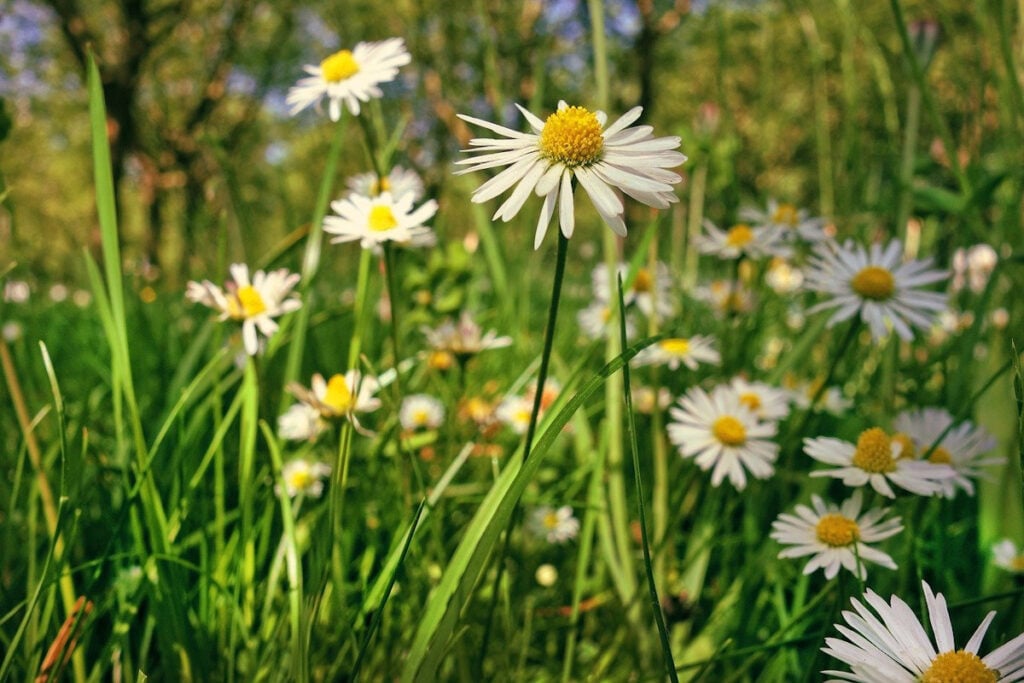
The common daisy (Bellis perennis), which can often be found growing on lawns and in meadows, has an edible flower that adds more beauty than taste to a dish. The individual petals are somewhat bitter but are small enough that you can add a few of these pleasing little buds to your salad or as a garnish without changing the flavor of your meal.
Many other species of daisy are also edible, including Shasta, oxeye, and chamomile, while some are toxic. Make sure you know which type of daisy you are dealing with before you dig in.
Magnolia
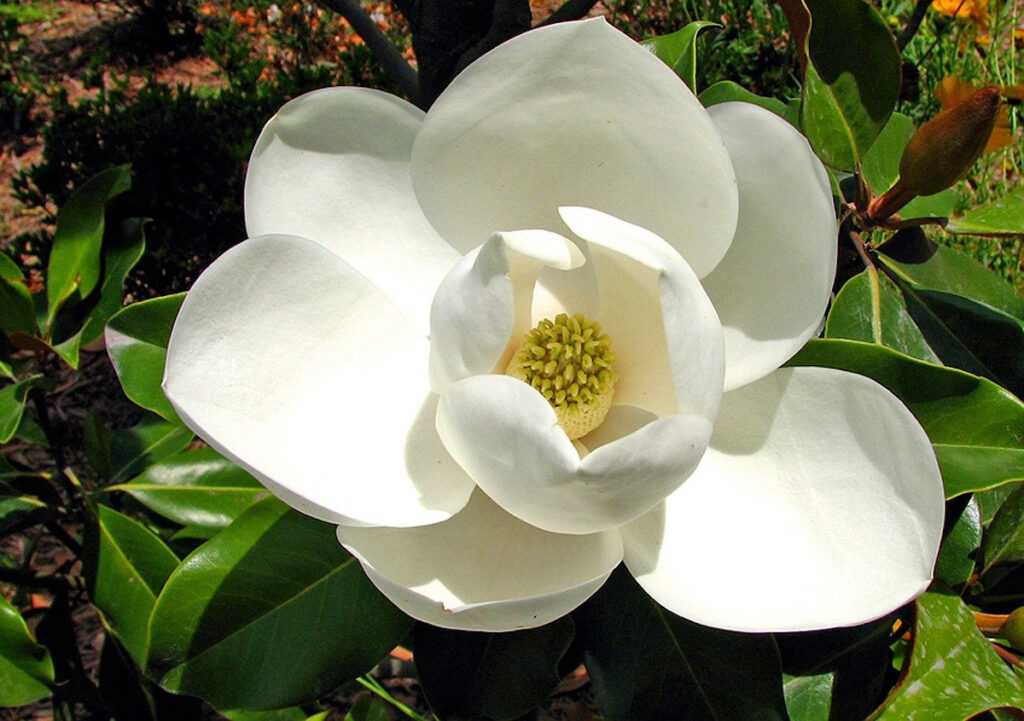
The thick, soft petals of the magnolia flower are good for more than just admiring. These white and pink blooms are actually quite flavorful. Somewhere between ginger and cardamom, magnolia flowers are spicy, sweet, and quite capable of overpowering the palate.
This intense flavor makes them a great candidate for pickling. They can also be brewed into a tea or chopped up and sprinkled on an Asian salad.
Just be aware that not all species of this plant taste the same and some may not be safe for eating. To be safe, stick to the species on this list.
Orchids
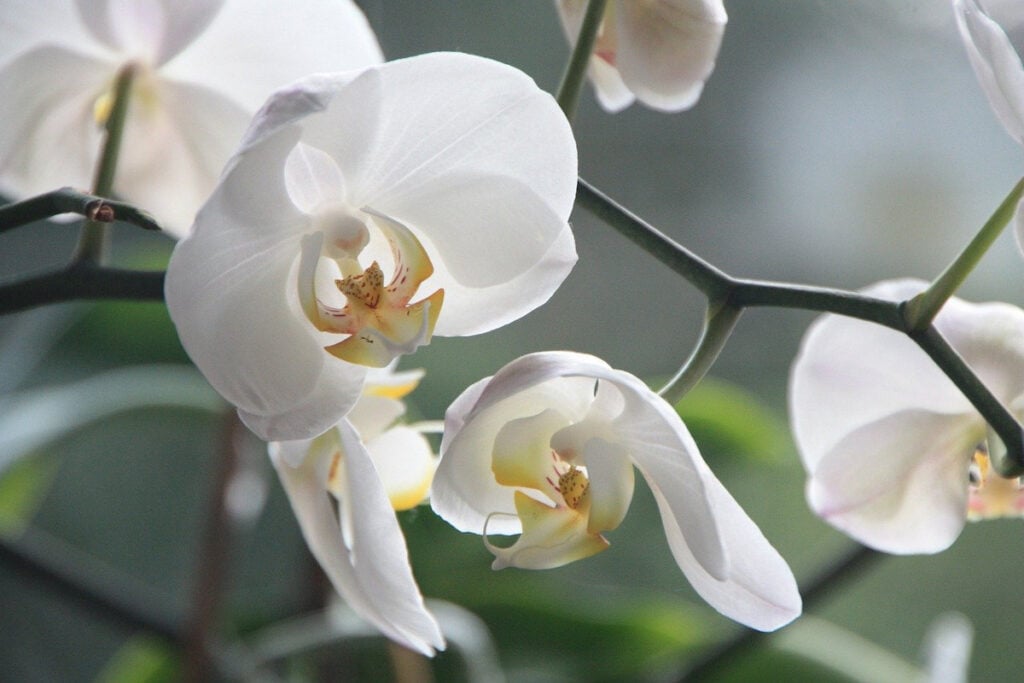
Eating exotic plants is rarely advised, but in the case of orchid flowers, it’s a-okay. In fact, the colorful petals of these plants are said to be quite delicious. They have a flavor reminiscent of crisp greens or lettuce.
You can enjoy orchids of any color on salads, gently sauteed with ramen or veggies, or candied and used as a cake topper. As with most flower-shop blooms, it’s best not to eat anything you buy at the florist unless you know it’s pesticide-free and grown organically.
See Also
Edible Orange Flowers
Nasturtium
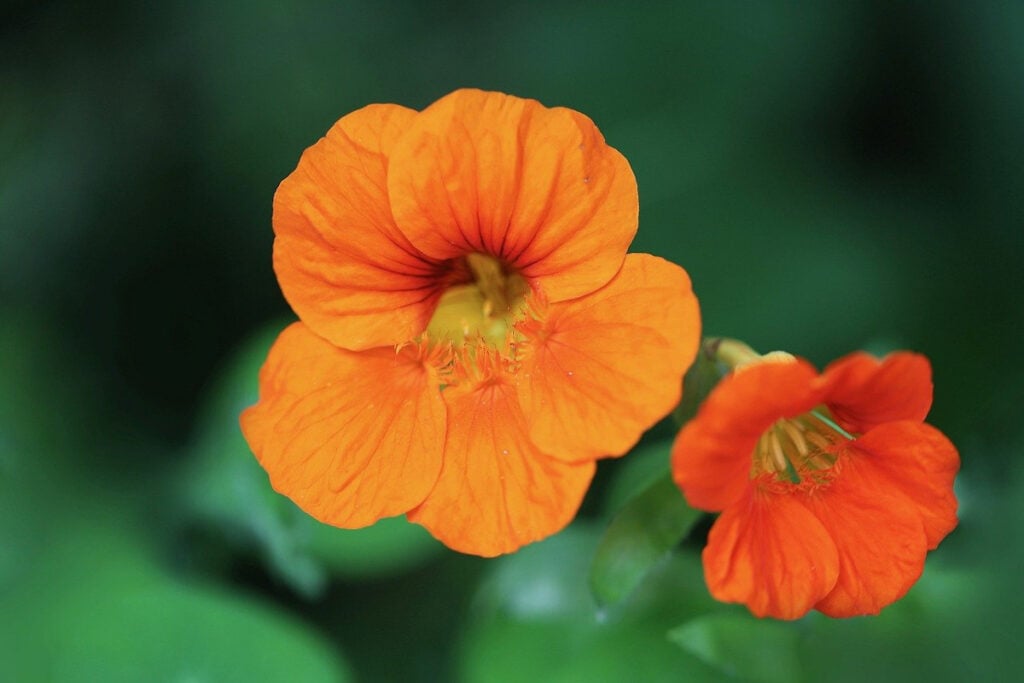
Nasturtiums are one of those rare flowers that are grown largely to be eaten. These colorful blooms add a visual appeal to salads, as well as a unique peppery flavor. In the vegetable garden, these beautiful flowers pull triple duty pulling pollinators in, providing flowers for various dishes, and providing leaves and petals to make medicinal salves for treating UTIs and respiratory infections.
Tulips
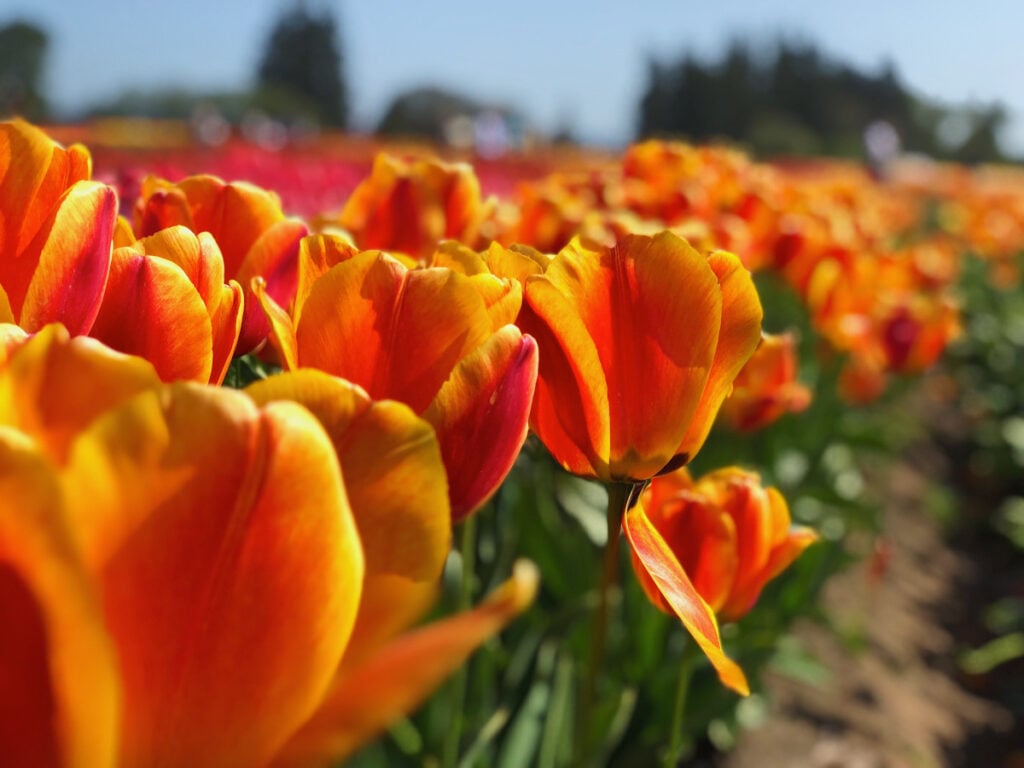
Tulip flowers are often used as beautiful serving dishes for dips and spreads, but the petals can be eaten, as well. The flavor of these flowers varies based on the variety and color, with the lighter pigmented petals typically being sweeter and the brighter colors having more of a bold flavor.
One of my favorite ways to enjoy these flowers is to cut out the stamens and fill the flower bowl with chocolate mousse or cheesecake filling and eat them whole.
See Also
Edible Blue Flowers
Borage
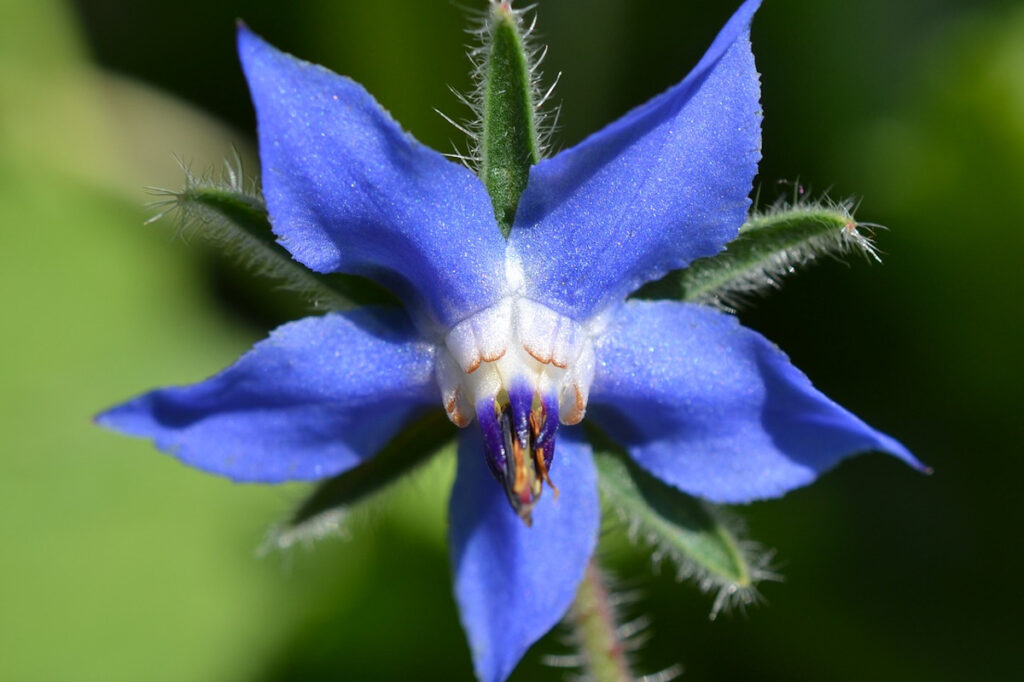
Borage flowers have a beautifully unique blue hue and fun star shape. They make for a great way to add a splash of whimsy to your plate.
These gorgeous flowers also have a surprising amount of flavor. The best way to describe it would be honey-sweet with a slightly salty aftertaste. This mild salty-sweetness makes for a great pairing in this cucumber salad but they work just as well in any veggie-heavy dish.
Rosemary
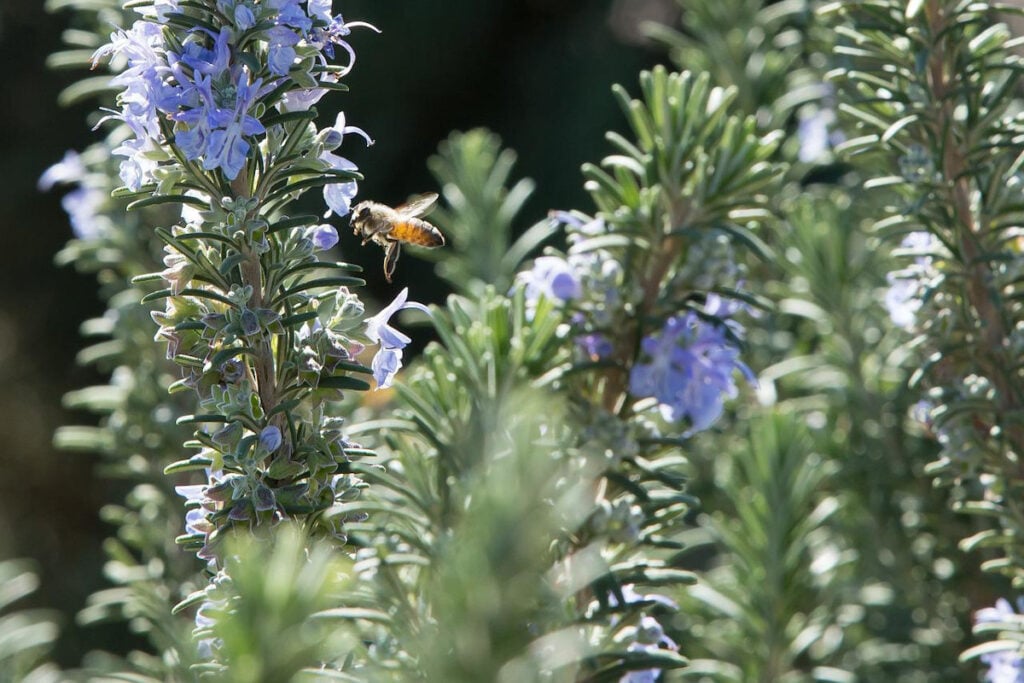
What is that striking blue thing growing up between the evergreen needles of your rosemary plant? It’s a tiny, edible flower, of course!
Like other herb flowers, rosemary flowers can be used as a similar tasting but more attractive garnish in many salads and savory dishes. Depending on the species of your rosemary, the flowers may have a milder flavor than the leaves or a much bolder flavor. So, be sure you try your flowers before sprinkling them over your next bowl of pasta.
See Also
What Is the Most Common Edible Flower?
There are a handful of edible flowers that even those who know nothing about foraging are probably aware of. Plenty of people have eaten fried squash blossoms and most have at least seen violets, pansies, or roses decorating a cake before.
These, along with dandelions, are the most well-known edible plants.
Can You Eat Flowers Raw?
All edible flowers can be eaten raw. Some, like rose petals and pansies, are quite delicious when eaten out of hand. Others, like sunflowers and lilacs, are best when cooked or prepared with sweeteners.
How Do You Know If A Flower Is Edible?
There is no way to tell if a flower is edible just by looking at it. Even some closely related flowers, such as those in the daisy family, include varieties that are toxic and varieties that are edible. If you’re unfamiliar with a flower or are not certain of its identification, you should not eat it.
If you’ve got some edible flowers and are ready to give them a try in a recipe, here’s a great one to start with. The ingredients are flexible, so make it your own and enjoy!
Edible Flower Salad
Ingredients
- several handfuls of mixed greens I used lamb's lettuc
- fresh broccoli florets
- kale microgreens
- handful of edible flowers pansies are pictured here
- 1-2 tbsp raw or sprouted nuts or seeds optional
- sea salt to taste
- fresh lemon juice
- olive oil as dressing
Instructions
- Chop all ingredients together so everything is bite-sized.
- Sprinkle with salt and mix.
- Dress with a big squeeze of fresh lemon juice and a generous drizzle of olive oil.

